#carbon water filter
Explore tagged Tumblr posts
Text
Activated carbon filters are porous materials used to purify air and water by trapping and removing contaminants through adsorption. They consist of activated carbon particles with a high surface area, providing an effective means of removing impurities such as chemicals, gases, odors, and organic compounds.
The activated carbon filters market size is projected to grow from USD 267 million in 2020 to USD 330 million by 2025, at a CAGR of 4.4%. The activated carbon filters market has been gaining significance with its major application in water treatment and air purification; the duo being its major applications. Stringent government regulations implying directives for industrial water pollution and quality drinking water have led to fast growth and acceptance of activated carbon filter products. These regulations are being implemented in the regions of Europe and North America and also gaining importance in the APAC region. The policies and regulations implemented by different authorities for supporting the use of activated carbon filters are attributing to the growth of activated carbon filters market.
#Activated Carbon Filters Market#Activated Carbon Filters Price#Activated Carbon Filter Manufacturers#Stainless Steel Shell#Carbon Steel Shell#carbon filter air purifier#activated carbon water filter#activated charcoal filter#activated charcoal water filter#air purifier with activated carbon filter#filter activated#granular activated carbon filter#catalytic carbon filter#activated carbon filters#carbon water filter#water filter charcoal#carbon air filter#blueair 411 filter#Activated Carbon Filters Market Analysis#Activated Carbon Filters Market Size#Activated Carbon Filters Market Share#Activated Carbon Filters Market Trends#Activated Carbon Filters Market Growth#Activated Carbon Filters Market Research#Activated Carbon Filters Market Revenue#Activated Carbon Filters#Global Activated Carbon Filters market#Activated Carbon Filters Market Overview#Activated Carbon Filters Research Report#Activated Carbon Filters research insights
0 notes
Text
Unlocking the Secret to Pure Water: Exploring Water Softener Solutions in Dubai
Introduction
Welcome to the oasis of knowledge in the desert of water concerns! In this comprehensive guide, we will delve into the world of water softeners, with a special focus on the dynamic city of Dubai. If you've ever wondered how to bid farewell to those pesky hard water problems, you're in the right place. Join us on a journey to discover the ins and outs of water softeners, specifically tailored for the unique conditions in Dubai.
water softener dubai: A Primer
Let's kick off our exploration by understanding the very foundation of our quest: water softeners in Dubai. What exactly is a water softener, and why is it crucial in this bustling metropolis surrounded by arid landscapes?
Water softeners are ingenious devices designed to combat the hardness of water, a common woe faced by many Dubai residents. Hard water, laden with minerals like calcium and magnesium, can wreak havoc on plumbing, appliances, and even your skin and hair. The solution? Enter the hero of our tale – the water softener!
Why water softener dubai Matters?
In a city where water quality is paramount, investing in a water softener becomes not just a choice but a necessity. Why, you ask? Well, hard water can leave stubborn stains on your fixtures, reduce the efficiency of appliances, and turn a relaxing shower into a hair-raising experience (literally!). With a water softener, you're not just investing in your comfort but also in the longevity of your home.

Choosing the Right water softener dubai: A Buyer's Guide
Now that we've established the importance of water softeners in Dubai, let's navigate the intricate process of choosing the right one for your needs. In a market flooded with options, it's crucial to be well-informed before making a decision.
Factors to Consider When Buying a water softener dubai
Water Hardness Levels in Dubai: Begin your journey by understanding the hardness levels of water in Dubai. Testing your water will empower you to choose a water softener that can handle the specific mineral content.
Type of Water Softener: From salt-based to salt-free, explore the different types of water softeners available. Each type has its own set of pros and cons, so pick one that aligns with your preferences and needs.
Capacity Matters: Consider the size of your household. A larger family might require a high-capacity water softener to ensure a steady supply of soft water.
Maintenance Requirements: Nobody wants a high-maintenance relationship, especially with a household appliance. Opt for a water softener that suits your lifestyle and maintenance capabilities.
Eco-Friendly Options: Dubai, a city embracing sustainability, offers eco-friendly water softener alternatives. Explore options that align with your commitment to a greener lifestyle.
Installing and Maintaining Your water softener dubai
Congratulations on choosing the perfect water softener for your Dubai abode! Now, let's dive into the nitty-gritty of installation and maintenance.
Installation Tips for Your water softener dubai
Strategic Placement: Install your water softener near the water entry point to ensure all water entering your home undergoes the softening process.
Follow Manufacturer Guidelines: Respect the wisdom of the manual. Each water softener comes with specific installation instructions – follow them diligently for optimal performance.
Check Water Pressure: Ensure that the water pressure is within the recommended range. Adjust if necessary to prevent damage to your newly installed water softener.
Bypass Valve Knowledge: Familiarize yourself with the bypass valve. It allows you to temporarily disable the water softener for maintenance without disrupting your water supply.
Maintaining Your water softener dubai for Longevity
Salt Resupply: If you have a salt-based water softener, keep an eye on salt levels. Regularly replenish salt to ensure continuous soft water production.
Clean the Brine Tank: Over time, the brine tank can accumulate impurities. Periodically clean it to maintain the efficiency of the water softener.
Check for Leaks: A vigilant eye can save you from potential disasters. Regularly inspect your water softener for leaks and address them promptly.
Professional Check-Ups: Schedule professional maintenance checks to ensure that your water softener is operating at peak efficiency. Prevention is the best cure!
water softener dubai FAQs: Your Burning Questions Answered
It's time to address the queries buzzing in your mind. Let's unravel the mysteries of water softeners in Dubai with these frequently asked questions.
FAQ 1: How Does a water softener dubai Work?
Hard water contains minerals like calcium and magnesium. A water softener works by exchanging these minerals with sodium ions through a process called ion exchange, leaving your water soft and free from mineral deposits.
FAQ 2: Can I Drink Water from a Softener?
Yes, water from a water softener is safe to drink. However, some individuals may prefer the taste of hard water, so having a separate source for drinking water is an option.
FAQ 3: Do water softeners Waste Water?
Water softeners do consume water during the regeneration process. However, newer models are designed to be more water-efficient, minimizing waste.
FAQ 4: How Often Should I Add Salt to My water softener?
The frequency of adding salt depends on the size of the water softener and the hardness of your water. Check the salt levels regularly and add more as needed.
FAQ 5: Are There Alternatives to Salt-Based water softeners?
Yes, salt-free water softeners and electronic water conditioners are alternatives. They work by preventing minerals from accumulating rather than removing them.
Conclusion: Embracing the Soft Side of Dubai's Water
As we wrap up our journey through the realm of water softeners in Dubai, it's evident that these devices are more than just household appliances – they are guardians of comfort and protectors of your home's integrity. Choosing the right water softener tailored to Dubai's unique conditions ensures that your daily life flows smoothly, just like the pure water it provides.
So, if you find yourself battling the stubbornness of hard water, don't despair. Dive into the world of water softeners, and let the soft side of Dubai's water embrace you.
Unlock the secret to pure water – your journey begins with a water softener in Dubai!
#shower water filter#tap water filter#faucet water filter#water filter for shower head#well water treatment#carbon water filter#filtration systems#shower head water softener
0 notes
Text
youtube
Carbon Water Filters in Puratap Under Sink Water Purifiers
In this enlightening video, we delve into the world of carbon water filters, with a special focus on Puratap's exceptional under sink water purifiers. Join us as we unravel the science behind how these innovative under sink carbon water filters work to trap and remove chlorine, trihalomethanes, and other harmful chemical substances commonly found in tap water used for drinking and cooking. Discover how Puratap's cutting-edge technology ensures that your family enjoys clean, crisp, and refreshing water, right from the convenience of your kitchen sink. Say goodbye to contaminants and hello to a healthier hydration experience! Watch now to quench your thirst for knowledge on water purification.
Visit our page to learn more.
https://www.puratap.com.au/purification-system/
#carbon water filter#carbon filter water#carbon water filters#activated carbon water filter#carbon filters for water#water filter carbon#activated carbon filters in water treatment#water carbon filter#water filter carbon filter#activated carbon filters for water#activated carbon filter for water treatment#activated carbon water filter for home#carbon drinking water filter#carbon filter drinking water#carbon filter for drinking water#carbon filter for tap water#Youtube
0 notes
Text
look gotham probably has lead pipes, iykyk
#this is about how lead poisoning rates lead to higher crime rates cause lead poisoning fucks with your head#still hung up on the underground network of water and sewer pipes though#i bet gotham's filtration system is years out of date and the carbon filters need to be replaced#the fish in the harbor are mutated like dredge (video game)#cant rememver gotham's rivers and creeks but those are definitely contaminated too. therefore the groundwater most likely is#as well right. so what the fuck are they drinking in gotham. groundwater contamination is no joke and will kill you#gothamites built different i think#probably very common to die from liver diseases and malfunctions in gotham#or everyone is just slightly mutated from whatevers in the water and air#gotham would have a very high rate of lung and liver damage due to pollution and groundwater contamination
3 notes
·
View notes
Text
Who is the Carbon Filter Manufacturer For RO System
When it comes to choosing the best CARBON Filter Manufacturer, consumers seek high-quality products that can effectively purify water and remove impurities. CARBON filters are known for their ability to enhance water quality by reducing chlorine, contaminants, and odors, making them a popular choice for water filtration systems.
GlobeXi Private Limited Limited emerges as a leading CARBON Filter Manufacturer, offering top-notch filtration solutions under the brand names AMEQUA, KAZANNO, and IWA. With a commitment to innovation and customer satisfaction, Globexi Private Limited stands out as a reliable source for premium CARBON filters that cater to diverse consumer needs.

As one of the best CARBON Filter Manufacturers in the industry, Globexi Private Limited prioritizes the use of advanced technology and high-quality materials to ensure the effectiveness and durability of their products. By leveraging innovative filtration techniques, they deliver CARBON filters that not only provide clean and safe drinking water but also improve its taste and odor.
Consumers looking for top CARBON Filter Manufacturers can trust in the expertise and reputation of Globexi Private Limited to meet their water filtration requirements. With a diverse range of products designed to suit various preferences and budgets under the brand names AMEQUA, KAZANNO, and IWA, customers can find the perfect CARBON filter that aligns with their specific needs.

In addition to offering superior products, Globexi Private Limited emphasizes exceptional customer service and satisfaction. By providing comprehensive support and guidance, they ensure that consumers can make informed decisions and have a seamless shopping experience when choosing CARBON filters for their homes or businesses.
Whether you are searching for the best CARBON Filter Manufacturer or seeking top-of-the-line filtration solutions, Globexi Private Limited and its brands AMEQUA, KAZANNO, and IWA have you covered. Their dedication to quality, innovation, and customer-centric approach sets them apart as a trusted leader in the industry.
In conclusion, selecting the right CARBON Filter Manufacturer is crucial for ensuring access to clean and healthy drinking water. With Globexi Private Limited and its brands AMEQUA, KAZANNO, and IWA, consumers can benefit from premium CARBON filters that prioritize performance, longevity, and customer satisfaction. Investing in high-quality CARBON filters from a reputable manufacturer like Globexi Private Limited can lead to improved water quality and overall well-being.
GlobeXi Private Limited
Website: https://globexi.com/
Address: B-17, 2nd Floor, Sector – 64, Noida – 201301, Uttar Pradesh
Mobile:+91-9654110300
0 notes
Text
What you need to know about home water filtration.
Emergency Plumbing: Your Trusted Water Filtration Experts in North Shore and Northwest Chicago Suburbs.
With the most affordable deals for water filtration projects of all sizes, our services include:
Water Softeners.
Full-House Filtration Systems.
Well Water Filtration.
Reverse Osmosis (RO) Systems.
Ultraviolet (UV) Water Purification.
Carbon Filters.
Why Choose Emergency Plumbing?
At Emergency Plumbing, we believe everyone deserves access to clean, safe, and affordable water. Our expert team is committed to:
Top-Quality Products: We partner with industry-leading brands for reliable performance.
Affordable Pricing: Transparent, competitive pricing with no hidden fees.
Custom Solutions: Tailored systems to meet your household’s specific needs.
Expert Installation and Maintenance: Trust our licensed professionals to do the job right.
Schedule Your Consultation Today.
Ready to improve your water quality? Contact Emergency Plumbing for a free consultation and estimate. We proudly serve the North Shore and Northwest Chicago suburbs and are here to ensure your family enjoys clean, safe water at an unbeatable value.
Your perfect water solution is just a call away!
Phone 224-754-1984
www.emergencyplumbing.biz
#What you need to know about home water filtration.#Emergency Plumbing: Your Trusted Water Filtration Experts#in North Shore and Northwest Chicago Suburbs.#With the most affordable deals for water filtration projects of all sizes#our services include:#1. Water Softeners.#2. Full-House Filtration Systems.#3. Well Water Filtration.#4. Reverse Osmosis (RO) Systems.#5. Ultraviolet (UV) Water Purification.#6. Carbon Filters.#Why Choose Emergency Plumbing?#At Emergency Plumbing#we believe everyone deserves access to clean#safe#and affordable water. Our expert team is committed to:#• Top-Quality Products: We partner with industry-leading brands for reliable performance.#• Affordable Pricing: Transparent#competitive pricing with no hidden fees.#• Custom Solutions: Tailored systems to meet your household’s specific needs.#• Expert Installation and Maintenance: Trust our licensed professionals to do the job right.#Schedule Your Consultation Today.#Ready to improve your water quality? Contact Emergency Plumbing for a free consultation and estimate. We proudly serve the North Shore and#safe water at an unbeatable value.#Your perfect water solution is just a call away!#Phone#224-754-1984#www.emergencyplumbing.biz
0 notes
Text
I remember I would fuck around with soulmate filters, because why not and I’m aro, so love is not so much on the table. So I would cover up word soulmate with soda. But the thing is I don’t like soda.
#soda#soda sucks#I had gotten my video taken down and my account banned after each post#filter#aromantic#arospec#aromantism#pop#imagine if music genres were a soda flavor#soda vs pop#I just don’t like the bubbles in soda#which with the carbonation in mind makes me fucking hate sparkling water#you took the worst part of soda and decided to put it in the flavorless goodness that is water and you ruined it#I just wanted water#whhhyyyyyyy#I once bought a water but was so thirsty that I didn’t read the label and it was sparkling water#and I’ve held a grunge against sparkling water since#y’all are freaks#I have so much to do for finals#I forgot how math works#fuck math#*cries*#my to do list is to study make a hidey hole and to cry#that’s it#my priorities are in order
0 notes
Text
What are the benefits of using a cabinet water softener in your home?
A cabinet water softener is a compact and effective way to manage hard water in your house. It eliminates minerals that create limescale, such as calcium and magnesium, and has various benefits:
Protects Appliances & Plumbing
Soft water minimizes limescale accumulation in pipes and appliances, increasing their longevity and efficiency. This results in fewer repairs and replacements, which saves you money over time.
Healthy Skin and Hair
Soft water is softer on the skin and hair, avoiding the dryness and irritation caused by hard water. It makes your skin feel smoother and your hair softer and shinier.
Better Cleaning Results
Soft water makes soaps, shampoos, and detergents lather better, clean more efficiently, and rinse more easily. It also removes streaks and spots from dishes, glasses, and tiles.
Compact and Space-Saving
The cabinet design combines the softener and brine tank in a single unit, making it perfect for houses with limited space.
Cost and energy savings
Soft water enhances appliance performance and saves energy consumption, particularly in water heaters. It also reduces maintenance costs by avoiding scale buildup.
Investing in a water softener provides softer water, healthier living, and long-term savings for your home. It's a realistic solution for hard water problems.
#solar water heaters#water filters#water heaters#carbon filters#hard water softeners#sand filters#water softeners#iron filter#iron filters#hard water solutions
0 notes
Text
How Many Wastewater Treatment Plants Are There in Delhi, India?
Delhi, the bustling capital of India, is a vibrant city characterized by its rapid urban growth and diverse population. With such a high density of people, managing essential services, including wastewater treatment, becomes crucial. Wastewater management is vital for maintaining public health and environmental sustainability. In this article, we will delve into the number of wastewater treatment…

View On WordPress
#3D Aqua Water Treatment#Activated Carbon Filters#Advanced Wastewater Treatment#Affordable Sewage Treatment#Deionization Plants#Eco-Friendly Sewage Treatment#Effluent Treatment Plant#Global Water Treatment Services#High-Performance STP#Industrial RO Plant#Industrial Wastewater Treatment#ISO Certified Water Treatment#sewage treatment plant#Sewage Treatment System#STP#STP Manufacturer#Sustainable Water Treatment Solutions#Wastewater Management#Wastewater Treatment Solutions#Water Softener Systems#Water Treatment Company#water treatment plant#Water Treatment Technology
0 notes
Text
New filtration material could remove long-lasting chemicals from water
New Post has been published on https://thedigitalinsider.com/new-filtration-material-could-remove-long-lasting-chemicals-from-water/
New filtration material could remove long-lasting chemicals from water
Water contamination by the chemicals used in today’s technology is a rapidly growing problem globally. A recent study by the U.S. Centers for Disease Control found that 98 percent of people tested had detectable levels of PFAS, a family of particularly long-lasting compounds also known as “forever chemicals,” in their bloodstream.
A new filtration material developed by researchers at MIT might provide a nature-based solution to this stubborn contamination issue. The material, based on natural silk and cellulose, can remove a wide variety of these persistent chemicals as well as heavy metals. And, its antimicrobial properties can help keep the filters from fouling.
The findings are described in the journal ACS Nano, in a paper by MIT postdoc Yilin Zhang, professor of civil and environmental engineering Benedetto Marelli, and four others from MIT.
PFAS chemicals are present in a wide range of products, including cosmetics, food packaging, water-resistant clothing, firefighting foams, and antistick coating for cookware. A recent study identified 57,000 sites contaminated by these chemicals in the U.S. alone. The U.S. Environmental Protection Agency has estimated that PFAS remediation will cost $1.5 billion per year, in order to meet new regulations that call for limiting the compound to less than 7 parts per trillion in drinking water.
Contamination by PFAS and similar compounds “is actually a very big deal, and current solutions may only partially resolve this problem very efficiently or economically,” Zhang says. “That’s why we came up with this protein and cellulose-based, fully natural solution,” he says.
“We came to the project by chance,” Marelli notes. The initial technology that made the filtration material possible was developed by his group for a completely unrelated purpose — as a way to make a labelling system to counter the spread of counterfeit seeds, which are often of inferior quality. His team devised a way of processing silk proteins into uniform nanoscale crystals, or “nanofibrils,” through an environmentally benign, water-based drop-casting method at room temperature.
Zhang suggested that their new nanofibrillar material might be effective at filtering contaminants, but initial attempts with the silk nanofibrils alone didn’t work. The team decided to try adding another material: cellulose, which is abundantly available and can be obtained from agricultural wood pulp waste. The researchers used a self-assembly method in which the silk fibroin protein is suspended in water and then templated into nanofibrils by inserting “seeds” of cellulose nanocrystals. This causes the previously disordered silk molecules to line up together along the seeds, forming the basis of a hybrid material with distinct new properties.
By integrating cellulose into the silk-based fibrils that could be formed into a thin membrane, and then tuning the electrical charge of the cellulose, the researchers produced a material that was highly effective at removing contaminants in lab tests.
By integrating cellulose into the silk-based fibrils that could be formed into a thin membrane, and then tuning the electrical charge of the cellulose, the researchers produced a material that was highly effective at removing contaminants in lab tests. Pictured is an example of the filter.
Image: Courtesy of the researchers
Previous item Next item
The electrical charge of the cellulose, they found, also gave it strong antimicrobial properties. This is a significant advantage, since one of the primary causes of failure in filtration membranes is fouling by bacteria and fungi. The antimicrobial properties of this material should greatly reduce that fouling issue, the researchers say.
“These materials can really compete with the current standard materials in water filtration when it comes to extracting metal ions and these emerging contaminants, and they can also outperform some of them currently,” Marelli says. In lab tests, the materials were able to extract orders of magnitude more of the contaminants from water than the currently used standard materials, activated carbon or granular activated carbon.
While the new work serves as a proof of principle, Marelli says, the team plans to continue working on improving the material, especially in terms of durability and availability of source materials. While the silk proteins used can be available as a byproduct of the silk textile industry, if this material were to be scaled up to address the global needs for water filtration, the supply might be insufficient. Also, alternative protein materials may turn out to perform the same function at lower cost.
Initially, the material would likely be used as a point-of-use filter, something that could be attached to a kitchen faucet, Zhang says. Eventually, it could be scaled up to provide filtration for municipal water supplies, but only after testing demonstrates that this would not pose any risk of introducing any contamination into the water supply. But one big advantage of the material, he says, is that both the silk and the cellulose constituents are considered food-grade substances, so any contamination is unlikely.
“Most of the normal materials available today are focusing on one class of contaminants or solving single problems,” Zhang says. “I think we are among the first to address all of these simultaneously.”
“What I love about this approach is that it is using only naturally grown materials like silk and cellulose to fight pollution,” says Hannes Schniepp, professor of applied science at the College of William and Mary, who was not associated with this work. “In competing approaches, synthetic materials are used — which usually require only more chemistry to fight some of the adverse outcomes that chemistry has produced. [This work] breaks this cycle! … If this can be mass-produced in an economically viable way, this could really have a major impact.”
The research team included MIT postdocs Hui Sun and Meng Li, graduate student Maxwell Kalinowski, and recent graduate Yunteng Cao PhD ’22, now a postdoc at Yale University. The work was supported by the U.S. Office of Naval Research, the U.S. National Science Foundation, and the Singapore-MIT Alliance for Research and Technology.
#000#antimicrobial#approach#Bacteria#billion#bloodstream#carbon#Casting#cellulose#chemicals#chemistry#Civil and environmental engineering#clothing#college#contamination#crystals#deal#Disease#drinking#drinking water#engineering#Environmental#Fight#filter#Filters#firefighting#Food#forever chemicals#Foundation#fungi
0 notes
Text

Discover the best alkaline water purifier in Hyderabad with Sharks Innovation. Improve your health with our innovative filtration technology, which provides clean, alkaline water for your home or business. Shop for the top alkaline water purifier services.
#alkaline copper water purifier Hyderabad#alkaline water purifier dealers in Hyderabad#alkaline uv water purifiers Hyderabad#RO UV alkaline copper water purifier Hyderabad#Carbon sediment RO alkaline water purifier Hyderabad#alkaline water filters in Hyderabad#Ro water purifiers in Hyderabad#alkaline Ozoniser water purifier Hyderabad#alkaline ozone water purifier Hyderabad#Antioxidant alkaline water purifier Hyderabad#Water Ionizer in Hyderabad.
0 notes
Text
Nuwave Air Purifiers for Home Bedroom Up to 1361 Sq Ft, Portable Air Purifier with Air Quality Sensor, H13 True HEPA & Carbon Filter Captures Pet Hair Allergies Dust Smoke,18dB, Energy Star Certified
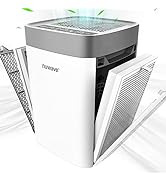
About this item
HIGH PERFORMANCE PORTABLE AIR PURIFIER - The True HEPA air purifier is perfect for large, indoor spaces, especially large bedrooms, living rooms, kitchens, and basements. Purify a 454 ft² room 3x per hour and a 1,361 ft² room 1x per hour.
TOUCH SCREEN CONTROLS – The LED touch screen is elegant and responsive; Easily control all 6 functions with a simple touch of the screen.
INDEPENDENT 3RD PARTY LAB CERTIFIED – The Portable Air Purifier is scientifically proven to remove 99.97% of airborne contaminants as small as 0.3 microns including dust, smoke, and pollen.
OZONE FREE – The Portable Air Purifier doesn’t utilize UV-C light, which can produce harmful ozone; It is also California Air Resource Board (CARB) certified to comply with that state’s stringent testing, electrical safety, and ozone requirements.
ENERGY STAR CERTIFIED – You can operate the Nuwave air purifier 24 hours a day for a year for less than $10 in electricity costs; It is also FCC and ETL certified.
ALLERGY RELIEF – Soothe congestion, watery eyes, sneezing & other allergy symptoms by purifying the air of allergens and allergy triggers that can irritate the sinuses, nasal passages, and lungs.
ENJOY BETTER SLEEP - The Portable Air Purifier is designed with Sleep mode; All indicator lights turn off and fan operates at whisper-quiet level 17.38 dB to help promote ideal sleeping conditions.
DUAL 3-STAGE FILTRATION – H13 True HEPA filter, carbon, and pre-filter are powerfully engineered to effectively purify the air in a 1,361 square foot room with 24 full air exchanges per day. It’s proven to remove most harmful particles from the air.
SMART TECHNOLOGY BUILT-IN – Auto function utilizes sensors to continuously monitor air quality in the room and automatically adjusts fan speeds for optimal purification. Only use NuWave replacement filters (search B0BHM8WD9K) for best results and product performance.
TRAVEL-FRIENDLY - This sleek, lightweight clean air solution blends seamlessly into any space; It’s perfect for hotel rooms, small apartments, bedrooms & dorms; It is compact and even fits in most carry-on bags so you can enjoy fresh air anywhere you travel.
You can try this product. Click & Buy Now
Product Description
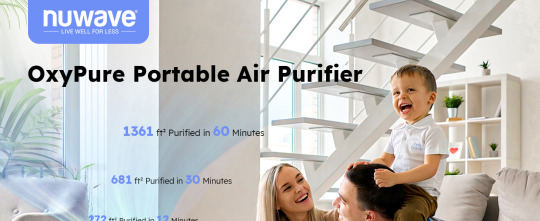

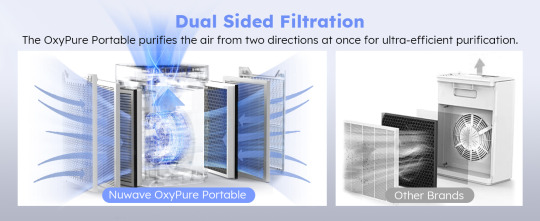

Thoughtful Design, Exclusively for You!
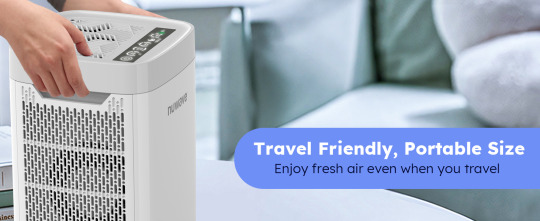
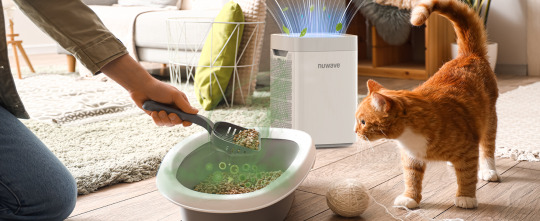
You can try this product. Click & Buy Now
Product information
Color: White and Gray Brand: Nuwave Product Dimensions: 8.62"D x 8.62"W x 12.75"H Specification Met: Energy Star Certified, FCC Certified, ETL Certified, CARB Certified, EPA Certified Noise Level: 18.5 dB Particle Retention Size: 0.3 Micron Controller Type: Button Contro Wattage: 34 watts UPC: 652185900196 Manufacturer: Nuwave Item Weight: 4.88 pounds ASIN: B0BRQRJMWG Country of Origin: Chain Item model number: 47402
Customer Reviews
4.4 4.4 out of 5 stars 346 ratings 4.4 out of 5 stars
Best Sellers Rank# 201,395 in Home & Kitchen (See Top 100 in Home & Kitchen) #277 in HEPA Filter Air Purifiers Care instructions: Wipe down with a damp cloth Assembly required: No Number of pieces: 1 Batteries required: No Included Components: 1 x Nuwave OxyPure Portable Air Purifier, 2 x H13 HEPA/Carbon Filters (Pre-installed), 1 x Power Supply, 1 x User Manual
Customer reviews Customers like the quality, performance, appearance and ease of operation of the air purifier. For example, they mention it's an amazing all around great air purifying machine that helps keep air quality up. Some appreciate the high-tech nature and mention it looks great. That said, opinions are mixed on noise, and size.
Desclaimer There are an affiliate links fo a best product in this article which may make some profit for me. You can try this product. Click & Buy Now
#Nuwave Air Purifiers for Home Bedroom Up to 1361 Sq Ft#Portable Air Purifier with Air Quality Sensor#H13 True HEPA & Carbon Filter Captures Pet Hair Allergies Dust Smoke#Energy Star Certified#Homedics#Tabletop water fountain#Home décor#Soothing sound machine#Automatic pump#Deep basin#Natural river rocks#Indoor zen relaxation#Office décor#Living room décor#Bedroom décor#Zen fountain#Relaxation fountain#Indoor water feature#Water fountain#Tabletop décor#Stress relief#Home office#Zen garden#Water feature#Meditation fountain#Peaceful ambiance#Fountain with pump#Small water fountain#Home relaxation#Indoor waterfall
1 note
·
View note
Text
The Ultimate Guide to Carbon Water Filters for Home
In today’s world, access to clean, safe drinking water is more critical than ever. Contaminants lurk in even the most seemingly pristine water sources, posing health risks to unsuspecting families. Enter carbon water filters, a robust solution to this pervasive issue. These filters have gained popularity due to their efficacy and reliability, making them an essential addition to any household.
Why Choose Carbon Water Filters?

Carbon water filters for home use are engineered to remove a plethora of impurities, ensuring the water you consume is pure and safe. These filters leverage activated carbon, a form of carbon processed to have small, low-volume pores that increase the surface area available for adsorption or chemical reactions. Activated carbon is a powerhouse, efficiently eliminating chlorine, volatile organic compounds (VOCs), and even unpleasant odors and tastes from tap water.
The functionality of carbon filters for water is rooted in their ability to trap contaminants within their porous structure. When water passes through these filters, impurities adhere to the carbon, allowing clean water to flow through. This process, known as adsorption, is particularly effective for organic compounds and chlorine, which are common culprits in municipal water supplies.
The Science Behind Carbon Block Filters
Carbon block filters are a refined variant of carbon filters, offering superior filtration capabilities. They are composed of finely ground carbon particles compressed into a solid block. This structure provides a larger surface area for adsorption, which translates to more efficient contaminant removal. Additionally, carbon block filters have a tighter pore structure, enabling them to remove smaller particles that granular activated carbon (GAC) filters might miss.
One of the standout features of carbon block filters is their ability to reduce lead content in water. Lead, a toxic metal, can leach into water supplies from old pipes and infrastructure. Long-term exposure to lead can lead to serious health problems, particularly in children. By using a carbon block filter, homeowners can safeguard their families against this hazardous contaminant.
Benefits of Using Carbon Water Filters
Improved Taste and Odor: One of the most immediate benefits of using carbon filters is the significant improvement in water taste and odor. Chlorine, often used in water treatment, can impart an unpleasant taste and smell to tap water. Carbon filters remove these elements, providing fresh, clean-tasting water.
Health Benefits: By removing harmful contaminants like chlorine, VOCs, and lead, carbon filters contribute to better health. These contaminants can cause various health issues, from skin irritation to more severe conditions like cancer and developmental problems in children.
Environmental Impact: Utilizing a carbon water filter reduces the reliance on bottled water, which is not only expensive but also environmentally damaging. Plastic bottles contribute to significant environmental pollution. By filtering tap water, you can minimize your carbon footprint and promote sustainability.
Cost-Effective: While the initial investment in a carbon water filter system might seem high, it pays off in the long run. The cost per gallon of filtered water is significantly lower than that of bottled water. Over time, homeowners will notice substantial savings.
Selecting the Right Carbon Water Filter
When choosing a carbon water filter, consider the following factors to ensure you select the best option for your home:
- Filter Life: Different filters have varying lifespans. Check the manufacturer’s recommendations for how often the filter needs to be replaced. A longer filter life means less frequent replacements and lower maintenance costs.
- Certification: Look for filters that are certified by organizations like NSF International. Certification ensures that the filter meets rigorous standards for contaminant reduction.
- Flow Rate: The flow rate of the filter affects how quickly you can access filtered water. Ensure the filter you choose has a sufficient flow rate to meet your household’s needs.
- Installation and Maintenance: Consider how easy it is to install and maintain the filter. Some systems require professional installation, while others can be easily set up by homeowners.
Conclusion
Investing in carbon water filters for home use is a prudent decision for anyone looking to ensure their family’s access to clean and safe drinking water. These filters offer an effective and economical solution to a range of water quality issues, from removing harmful contaminants to improving taste and odor. By selecting the right carbon filter, homeowners can enjoy the myriad benefits of pure water, contributing to better health and a more sustainable environment.
For more information on carbon water filters, visit H2O Filter’s Carbon Block Technology. Enhance your home’s water quality with cutting-edge filtration technology today.
0 notes
Text
Carbon water filter cartridge
Water containing chlorine, organics, color, tannin, and unwanted tastes and odors can be cleaned with a carbon water filter cartridge. Carbon and special chemical binders are mixed and then pressed under a lot of pressure to make activated carbon blocks or capsule filters. The market is full of blocks that may look good outside but might not perform well or last long. You won't have to worry about it if you use the filter cartridges from C L services.
0 notes
Text
Aquarius Projects | Sustainable Recycling & Recovery Systems
Aquarius Projects offers water treatment recycling & recovery systems aiming to minimize waste, maximize resources & promote sustainability through solutions
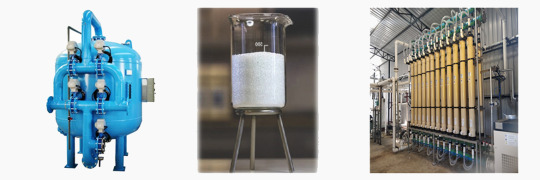
#recycling and recovery systems for water waster management plant#tertiary And recycling and recovery equipments in india#pressure sand filters in gujarat#ultra filtration system in vadodara#ceramic membrane system in gujarat#activated carbon filters in india
0 notes
Text
n the quest for clean and safe drinking water, many households are turning to granular activated carbon (GAC) water filters as a reliable solution. With concerns over contaminants like chlorine, volatile organic compounds (VOCs), and even certain heavy metals in tap water, the need for effective filtration systems has never been more pressing.
0 notes